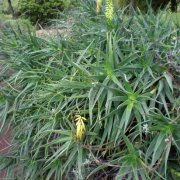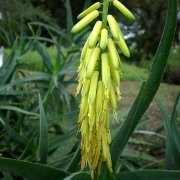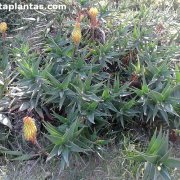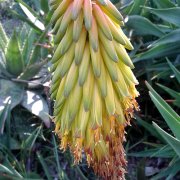Care of the succulent plant Aloe tenuior or Fence aloe |
|
The genus Aloe is included in the subfamily Asphodeloideae (family Xanthorrhoeaceae), which comprises about 500 species of succulent plants native to Africa, Madagascar and the Middle East. Some species are: Aloe tenuior, Aloe x caesia, Aloe pluridens, Aloe suprafoliata, Aloe striata, Aloe plicatilis, Aloe mitriformis, Aloe marlothii, Aloe maculata, Aloe juvenna, Aloe ferox, Aloe ciliaris, Aloe barberae, Aloe x delaetii, Aloe aristata, Aloe arborescens, Aloe aculeata, Aloe variegata, Aloe vera, Aloe x spinosissima, Aloe thraskii, Aloe esculenta. Common name: Fence aloe. This species is native to South Africa. They are creeping succulent plants that have up to 20 leaves per stem and reach more than 2 meters (6.56 feet) in length. They have thin bluish-green leaves (up to 18 cm/7" in length) with small teeth on the margin. The showy yellow or red flowers are cylindrical in shape and appear in clusters above the plant. They bloom in winter but can flower at other times of the year. Fence aloe is an easy to grow plants that are used as coverings, to form informal hedges, in beds, in rockeries or in pots. Aloe tenuior is grown in full sun or light shade exposure. They resist frost of -3 ºC (26.6 ºF) but it is better that the winter temperature does not drop below 3 ºC (37.4 ºF). Fence aloe can grow in sandy and rocky soils but prefer that they contain organic matter; good drainage is very important. Aloe tenuior is a quite drought resistant plant but prefer regular watering during spring and summer. It is advisable to wait for the soil to dry before watering. Fertilize with compost in the fall. It's advisable to prune the withered inflorescences. Aloe tenuior can be attacked by insects and mealybugs. Fence aloe propagates from cuttings that should be left to dry for a couple of days and that can be planted directly in their final location. |
Images of the succulent plant Aloe tenuior or Fence aloe |
Find plants
Aloe tenuior or Fence aloe | Care and Growing
© 2025 FavThemes



